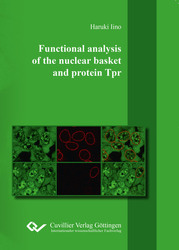| Areas | |
|---|---|
| Serie de libros (96) |
1378
|
| Nachhaltigkeit |
3
|
| Gesundheitswesen |
1
|
| Letra |
2364
|
| Ciencias Naturales |
5406
|
| Matemática | 229 |
| Informática | 319 |
| Física | 980 |
| Química | 1363 |
| Geociencias | 131 |
| Medicina humana | 243 |
| Estomatología | 10 |
| Veterinaria | 108 |
| Farmacia | 147 |
| Biología | 835 |
| Bioquímica, biología molecular, tecnología genética | 121 |
| Biofísica | 25 |
| Nutrición | 45 |
| Agricultura | 1004 |
| Silvicultura | 201 |
| Horticultura | 20 |
| Ecología y conservación de la tierra | 148 |
| Ciencias Ingeniería |
1793
|
| General |
98
|
|
Leitlinien Unfallchirurgie
5. Auflage bestellen |
|
Erweiterte Suche
Functional analysis of the nuclear basket and protein Tpr (Tienda española)
Haruki Iino (Autor)Previo
Indice, PDF (56 KB)
Lectura de prueba, PDF (190 KB)
A large coiled-coil protein, Tpr (Translocated promoter region) is located at the nuclear side of the nuclear pore complex (NPC), and plays an important role in the architecture of the nuclear basket (NB). Although its contribution to the NB structure has been characterized, little is known about the function of Tpr. In this work, we investigated whether and how Tpr contributes to the surveillance of mRNA export, especially, to the quality control (QC) of certain un-spliced mRNAs.
To answer these questions, we established a series of different reporter cell lines, allowing us to monitor the occurrence of un-spliced and spliced reporter transcripts. In the analysis of most of these reporter cell lines, the depletion of Tpr did not cause any obvious leakage of un-spliced reporter mRNAs. However, when the coding sequence of the HIV (Human immunodeficiency virus) Gag protein was used as a readout, the cytoplasmic levels of the un-spliced HIV-gag mRNAs were highly enhanced in the absence of Tpr. Such phenotype was only observed when a viral RNA export enhancer element, the CTE (the constitutive transport element), that recruits the general mRNA export receptor, NXF1/TAP, was part of the HIV-gag reporter gene. Intriguingly, a slight reduction in the cellular Tpr levels already caused the breakdown of a retention mechanism that normally keeps these HIV-gag transcripts in the nucleus. Results obtained with this and other transcripts showed that Tpr can indeed play a role in keeping certain transcripts within the nucleus in an export-pathway-dependent manner. However, they also reveal that this Tpr-dependent retention mechanism does not monitor intron-containing transcripts in general. In fact, at least in the case of the HIV-gag transcript, such retention did not depend on the presence of splice sites, the branch point sequence (BPS), or the poly-pyrimidine track (PPT). How such retention of certain transcripts along a distinct export pathway might be mechanistically explainable is being discussed.
| ISBN-13 (Impresion) | 9783736995895 |
| ISBN-13 (E-Book) | 9783736985896 |
| Formato | A5 |
| Idioma | Inglés |
| Numero de paginas | 152 |
| Edicion | 1. |
| Lugar de publicacion | Göttingen |
| Lugar de la disertacion | Göttingen |
| Fecha de publicacion | 24.11.2017 |
| Clasificacion simple | Tesis doctoral |
| Area |
Biología
|
| Palabras claves | Functional, analysis, protein |








